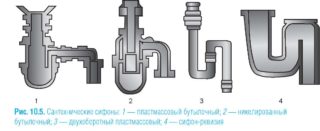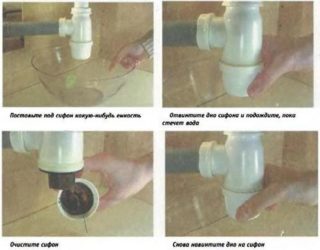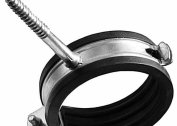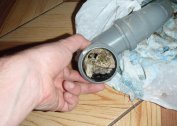Water lock - an important node in the scheme of connecting plumbing equipment to sewers in a private house or apartment. Such devices are also called siphons. There is always some water in the water seal, which creates a cork against odors from the pipes. It also performs a protective function for the sewer system, blocking water hammer.
The principle of operation of the sewer shutter
 Hydraulic locks are structurally different, but for the most part they are curved pipe sections. Sometimes they are equipped with additional nodes.
Hydraulic locks are structurally different, but for the most part they are curved pipe sections. Sometimes they are equipped with additional nodes.
The purpose of the device is to block sewer odors and water hammer, which reduces the load on the spillways.
The scheme of the device is based on the principle of communicating vessels. Water in the knee blocks it, preventing the seepage of sewer gases into the living room. When using plumbing fixtures, the shutter is filled with water again, which prevents the stagnation of fluid in it, the accumulation of dirt and drying out.
Water locks are mounted not only in bathrooms and bathrooms. Many sewer wells are equipped with a similar device to prevent backflow of drains.
Types of hydraulic locks
 According to the design features, six variants of hydraulic locks are distinguished.
According to the design features, six variants of hydraulic locks are distinguished.
Knee. It looks like a horseshoe. It has a couple of excesses - at the entrance and at the exit. The point of the latter should be located slightly lower than the first (50-60 mm). Sometimes the knee has the form of the letter S, the principle of operation of such a device is similar. The main advantage of knee closures is their strength. They restrain water hammer as much as possible. The shutter throughput depends on the diameter of the pipe. It should not be less than the release of plumbing equipment. Most often, knee devices are installed on the sinks of the toilet or bath. It is possible to connect two devices at once.
Bottle. It has the shape of a bulb. It is very simple to disassemble, clean and rinse. The inlet pipe is connected to the drain hole of the plumbing equipment, and the outlet pipe to the sewer. If the water seal becomes clogged, the sewage system “rises”. In this case, clean the siphon. This is easy to do on your own: remove the device and disassemble and rinse. Such devices have one more advantage - a decoration that has fallen into a sink or a bathtub will not float into the sewers. It is easy to remove by removing the siphon.
Two-turn. Structurally similar to the knee version, but more complex. The drain pipe fits into the plumbing outlet, the connection is blocked by a filter grate. Hair and other debris linger on it. The pipe bend is connected to an additional pipe located with a slight slope. It fits into the drain hole. This type of hydraulic lock protects against leaks, it can be adjusted and is easy to install even in a narrow opening.
Corrugated Siphon. Durable, plastic, convenient for small bathrooms. Due to the flexibility of the corrugated pipe, such a device can be installed in the opening of any configuration where other siphons simply do not fit. The corrugated part can be rotated and bent at any angle - even plastic siphons do not have such quality, not to mention metal ones. The disadvantage is that debris settles quickly on the ribbed walls, which leads to clogging of the system. If you do not clean the corrugated siphon for a long time, it becomes less durable due to dirt, which weighs a lot. The device will lose strength and elasticity, may crack.
With overflow. The design includes an additional pipe that creates an overflow. Thanks to this, the plumbing room is protected from flooding if the drain becomes clogged or the sewer does not cope with the flow of water. Most often used for bathtubs.
Dry. They are installed in those rooms that are used from time to time, for example, in country bathrooms or in baths. The design of such a device does not require the constant presence of fluid inside. It is optimal to combine such a device with a knee or bottle closure.
Self-made siphon
Simple plastic siphons are inexpensive. The average price of a hydraulic sewer bottle closure with corrugated outlet and stainless mesh is 90-100 rubles. Complex structures or devices made of metal are more expensive. Their price starts at 2,000 rubles.
If it is not possible to buy a suitable siphon or want to save money, you can create a water trap for sewage from improvised tools with your own hands. To do this, you need a pipe and a plastic sleeve, a knife, a screwdriver and an adjustable wrench. The actions for manufacturing a water seal are simple:
- The pipe is bent in the shape of a horseshoe.
- Combined with a coupling 60 mm high.
- Dock to the drain funnel or weld to the hole of the sewer pipe.
With your own hands you can make a dry shutter. Use a regular tennis ball. It must be laid so that it closes the entrance to the sewer pipe. When the water goes, it will float and ensure its patency.
Installation Rules
Installing shutters is not the most difficult process. The easiest way to connect a bottle siphon under the sink in the kitchen. In a bathroom or a bath - a little more complicated. But also it will not be difficult for a person who owns the basic skills to work with the tool.
Instructions for installing a new siphon instead of the old:
- Turn off the water and place a basin or floor rag under the device.
- Unscrew the fasteners securing the shutter. If they are stuck, just split the device and carefully remove it from the system.
- Remove the device and plug the pipe hole with a roll of rags so that no smell comes out of it.
- Clean the docking areas.
- Install the protective grill to the drain. To do this, use a sealant that comes complete with a shutter or silicone.
- Fasten the connecting pipe to the grille with a long screw.
- Put on the nozzle a flare nut, a conical gasket, and then - a water lock, adjust the height.
- Connect the outlet pipe to the sewer hole.
Test the quality of the joints: let water through and check for droplets or trickles on the surface.
Connect the valve with the outlet pipe carefully to ensure tightness. Otherwise, leaks cannot be avoided.
The cross-section of the water seal is smaller than the sewer outlet, so a ring of rubber or plastic about 15 mm thick is mounted on it. Its outer diameter must exactly coincide with the cross-section of the socket, and the inner one - with the dimensions of the outlet pipe of the shutter.
Possible malfunctions and installation errors
 The cause of sewer odor and poor shutter performance may be a lack of water in the knee. This happens if it just evaporated due to a long non-use of plumbing. Sometimes problems arise due to errors when installing the device:
The cause of sewer odor and poor shutter performance may be a lack of water in the knee. This happens if it just evaporated due to a long non-use of plumbing. Sometimes problems arise due to errors when installing the device:
- incorrectly selected pipes;
- failures in a bias of horizontal lines;
- leakage of drain pipes due to improper connection.
If this is not the case, the water trap may be clogged. It must be disassembled and rinsed thoroughly.
If the hydraulic shutter is selected correctly, unpleasant odors do not penetrate into the living room, the sewage system goes without repair for a long time.




